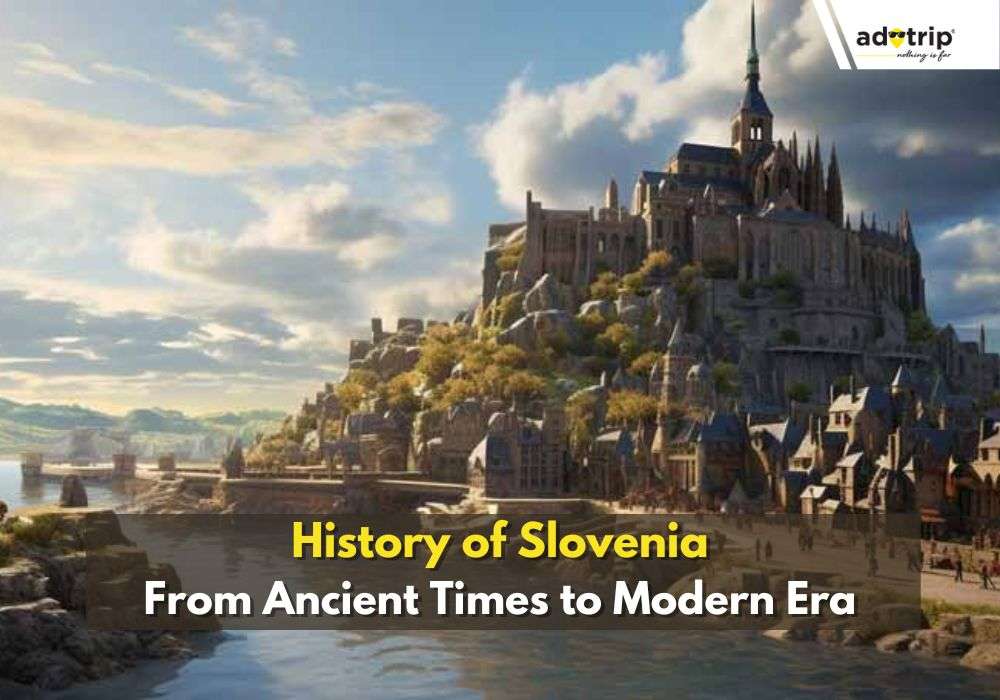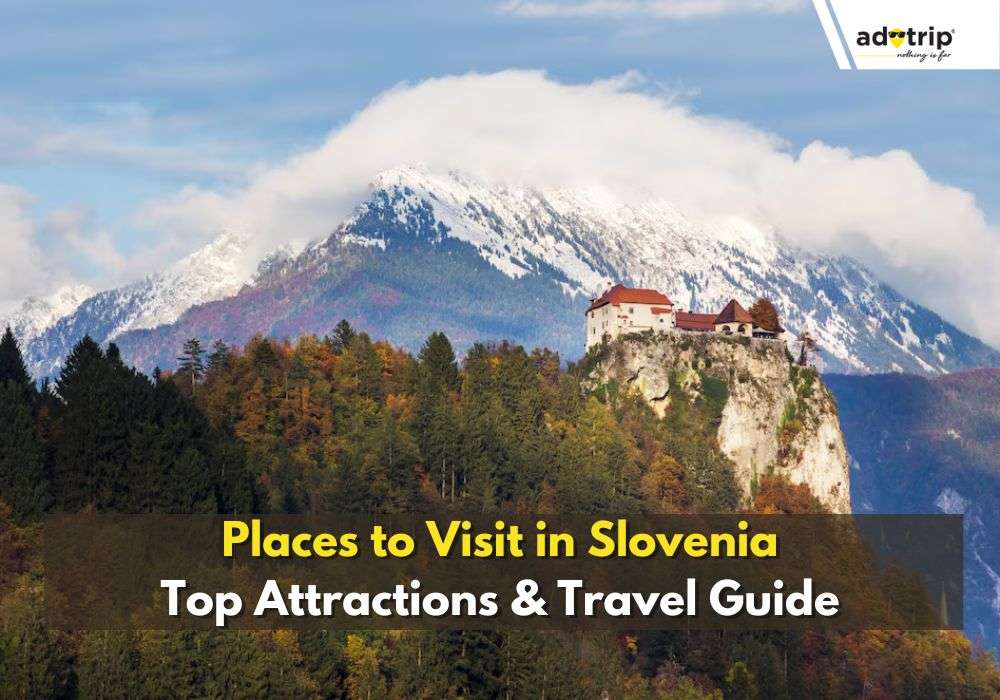
Last Updated At: 23-Jan-2025
Discover the History of Slovenia – From Ancient Times to Modern Era
Located in the heart of Europe, Slovenia boasts a unique blend of Alpine, Pannonian, Karst, and Mediterranean landscapes, shaping its rich culture and cuisine. Winter, from December to February, unveils the country's charm. In just three days, explore Ljubljana, relax on Lake Bled, visit the Postojna Cave, and discover the coastal town of Piran. Ljubljana Airport serves as a convenient gateway. Immerse yourself in the captivating history of Slovenia, tracing its journey from ancient roots to modern identity. Discover a nation with a distinctive character forged by its diverse geography and cultural tapestry. Experience Slovenia's history firsthand with us. Stay Tuned!
History of Slovenia - Architects of Identity
As you journey through Slovenia's captivating history, you'll witness the convergence of landscapes and cultures. Explore the nation's rich tapestry, where each region—Alpine, Pannonian, Karst, and Mediterranean—adds a unique hue to its story. From ancient roots to modern allure, Slovenia invites you to delve into a fascinating narrative. So, let's begin, voyagers!
- Ancient Slovenian History | Pannonian Influences
- Medieval Slovenia | Kingdoms Emerge
- Habsburg Rule | Cultural Renaissance
- Napoleonic Era | Shifting Borders
- Yugoslav Federation | Unification Struggles
- World War I | Turmoil and Transformations
- World War II | Occupation and Resistance
- Socialist Yugoslavia | Tito's Legacy
- Independence | Breakup of Yugoslavia
- European Union | Slovenia's Integration
1. Ancient Origins - Pannonian Influences
In delving into Ancient Slovenian History, we uncover the deep roots of the Slovenian people, influenced by the Pannonian region. The origins of Slovenia trace back to this era, marked by a rich tapestry of tribal communities. Notable figures in Slovenian history emerged from this time, shaping the early identity of the region. The unique heritage of Slovenia, grounded in ancient traditions, laid the groundwork for the cultural evolution that would follow.
2. Medieval Slovenia - Kingdoms Emerge
The Medieval Slovenia timeline unfolds with the emergence of kingdoms, ushering in a dynamic period of change and growth. Historical events in Slovenia during this era include the establishment of influential territories and the development of a distinct Slovenian identity. Notable figures played pivotal roles in steering the course of mediaeval Slovenia, contributing to forming a cohesive and culturally rich society.
3. Habsburg Rule - Cultural Renaissance
Under Habsburg rule, Slovenia experienced a cultural renaissance that left an enduring imprint on the nation's heritage. The historical events in Slovenia during this period witnessed the flourishing of arts, literature, and intellectual pursuits. The cultural evolution in Slovenia during Habsburg rule laid the foundation for a diverse and vibrant cultural landscape that continues to shape the nation's identity.
4. Napoleonic Era - Shifting Borders
The Napoleonic Era brought significant changes to Slovenia, with shifting borders and geopolitical transformations. Historical events in Slovenia during this time reflected the impact of wider European conflicts. The region experienced a flux of influences, contributing to the intricate tapestry of Slovenian history. Notable figures navigated these changes, leaving their mark on the evolving identity of the Slovenian people.
5. Yugoslav Federation - Unification Struggles
The formation of the Yugoslav Federation marked a chapter of unification struggles for Slovenia. Historical events unfolded as the nation sought to find its place within this complex political entity. The Slovenian heritage facts from this period include the resilient spirit of the people, who were determined to preserve their distinct identity within the diverse tapestry of the federation.
6. World War I - Turmoil and Transformations
World War I brought turmoil and transformations to Slovenia, as the region was on the frontlines of a global conflict. Historical events in Slovenia during this period include the challenges faced by the population and notable figures who emerged as leaders in times of crisis. The resilience of the Slovenian people during World War I contributed to shaping their national character.
7. World War II - Occupation and Resistance
During World War II, Slovenia faced occupation and resistance, becoming a battleground for opposing forces. Historical events in Slovenia reveal stories of bravery and sacrifice as the people resisted foreign occupation. Notable figures in Slovenian history rose to prominence through their roles in the resistance, leaving an indelible mark on the nation's collective memory.
8. Socialist Yugoslavia - Tito's Legacy
The era of Socialist Yugoslavia brought forth Tito's legacy, shaping Slovenia's political and social landscape. Historical events unfolded as the nation navigated the complexities of socialist governance. The heritage facts of Slovenia from this time include the challenges and achievements in building a unified and industrially progressive society within the Yugoslav framework.
9. Independence - Breakup of Yugoslavia
The quest for independence marked a pivotal moment in Slovenia's history during the breakup of Yugoslavia. Historical events unfolded as the nation declared its sovereignty, paving the way for a new chapter in its history. Notable figures played crucial roles in the diplomatic and political arenas, guiding Slovenia through the complexities of nation-building.
10. European Union - Slovenia's Integration
Slovenia's integration into the European Union represents a modern chapter in its history, characterised by economic growth and political stability. Historical events in Slovenia during this period include the nation's efforts to align with European values and standards. The cultural evolution of Slovenia continues as it engages with the broader European community, contributing to a shared heritage that transcends national borders.
Embark on a captivating journey through the History of Slovenia. Uncover the stories that shaped this diverse nation, from its ancient roots to the modern era. Join us in exploring the cultural tapestry and historical landmarks that define Slovenia's unique identity. Let history come alive as we navigate the twists and turns of this small yet extraordinary European gem. Dive into the past and discover the essence of Slovenia, a journey worth taking. Explore with us and experience the rich history that has moulded this country into the captivating destination it is today.
Plan your visit with Adotrip today. Obtain a wealth of information and end-to-end travel assistance and Book flights, hotels, and tour Packages under one roof.
Also Read: Tourist Places To Visit In Slovenia
With us, Nothing is far!
Book Slovenia Tour Packages
Frequently Asked Questions About the History of Slovenia
Q1. What is the earliest known history of Slovenia?
A1. The earliest known history of Slovenia dates back to prehistoric times, with evidence of human habitation in the region. The Illyrians, Celts, and later the Romans, notably in the city of Emona (modern-day Ljubljana), contributed to the area's cultural and historical foundation, shaping Slovenia's diverse heritage.
Q2. When did Slovenia gain independence from Yugoslavia?
A2. Slovenia declared independence from Yugoslavia on June 25, 1991. This move marked the beginning of the Ten-Day War, a brief conflict with Yugoslav forces, ultimately leading to international recognition of Slovenia's independence on January 15, 1992.
Q3. Can you explain Slovenia's role in the dissolution of Yugoslavia?
A3. Slovenia played a crucial role in the dissolution of Yugoslavia. In 1991, it declared independence, triggering a brief conflict with Yugoslav forces. The Ten-Day War resulted in international recognition of Slovenia's sovereignty. This event marked the beginning of Yugoslavia's disintegration, leading to the formation of independent nations in the region.
Q4. Who are some notable historical figures from Slovenia?
A4. Some notable historical figures from Slovenia include:
- France Prešeren (1800–1849): Slovenia's national poet.
- Josip Broz Tito (1892–1980): Born in Kumrovec (now in Slovenia), Yugoslav leader.
- Janez Vajkard Valvasor (1641–1693): Historian and polymath.
- Edvard Kardelj (1910–1979): Key figure in the Yugoslav Partisan resistance.
Q5. What major historical events have shaped modern Slovenia?
A5. Several major historical events have shaped modern Slovenia, including:
- World War II
- Independence from Yugoslavia (1991)
- EU and NATO accession (2004)
- Economic and Democratic Development
--- Published By Adotrip
Latest Blogs

Long Weekends In India 2025 - List of Holidays

Kazakhstan Travel Guide 2025: Affordable Luxury, Visa Free E...

Think Ayodhya is Just Temples? Discover Its Hidden Artistic...

Why Azerbaijan is the Best Budget Friendly Alternative to Sw...











 Dubai
Dubai Malaysia
Malaysia USA
USA





